Man's best friend could soon join fight against pandemic
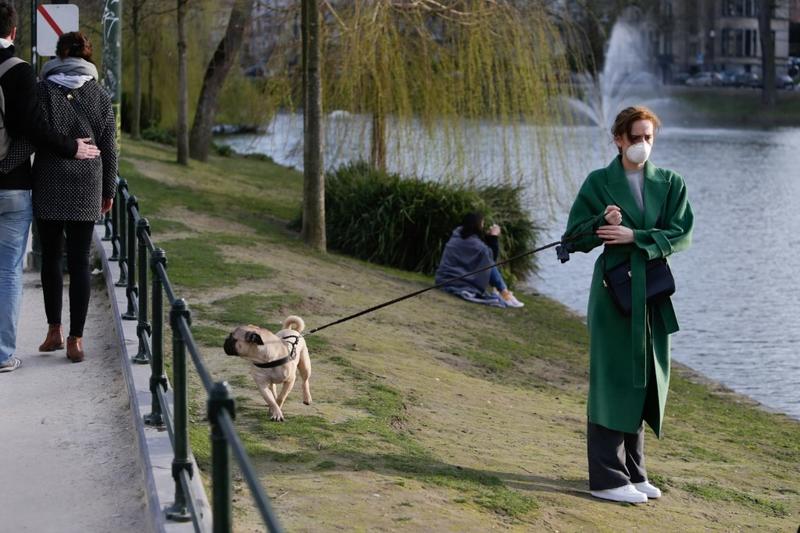 A woman wearing a protective face mask is walking her dog as the preventive measures related to COVID-19 still allow circulation in public places, in Brussels on March 17, 2020. (ARIS OIKONOMOU / AFP)
A woman wearing a protective face mask is walking her dog as the preventive measures related to COVID-19 still allow circulation in public places, in Brussels on March 17, 2020. (ARIS OIKONOMOU / AFP)
In a pristine, sunlit training room, Digby walked slowly and methodically around a strange circular contraption-a sort of metal carousel formed from a series of spokes with cups on the end.
The labradoodle, generally a sociable and playful companion, was on a mission.
There were eight cups to choose from, but only one would result in a treat and lavish praise from his trainer.
Digby sniffed one of the cups before moving on. Two more were investigated and abandoned-then success! With the target odor identified, he sat next to the cup and looked imploringly at his trainer, who rewarded him with a treat and by scratching the animal's head.
The dog is one of six involved in a COVID-19 detection training program at the headquarters of Medical Detection Dogs, or MDD, in Milton Keynes, southern England.
Armed with a similar amount of rigorous training as drug and explosives sniffer dogs, so-called bio-detection dogs are taught to detect volatile chemicals found in samples taken from clothing, skin swabs, urine or feces.
There is mounting evidence that these dogs can detect human ailments, including types of cancer, malaria and Parkinson's disease, with high levels of accuracy.
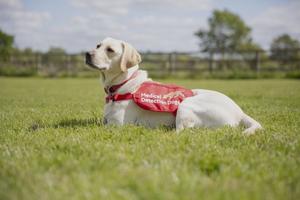 Star, the Labrador, works during a training course. (PHOTO / NEIL POLLOCK)
Star, the Labrador, works during a training course. (PHOTO / NEIL POLLOCK)
Digby and his canine colleagues are part of a project backed by the British government to see if the novel coronavirus infection has its own distinctive, detectable odor.
Andrew Whitby-Collins, MDD's chief operating officer, said: "If our research is successful, COVID-19 detection dogs could be deployed in public places such as airports. This would help prevent a second wave of the disease after we have brought the present pandemic under control."
A well-trained bio-detection dog can be used to assess 250 people in an hour, Whitby-Collins said.
If stationed at transportation hubs during the pandemic, the animals could conduct valuable primary screening for COVID-19 infection, swiftly working on long lines of travelers and indicating those who need to be tested for disease by sitting next to them or pointing their noses at them.
James Logan, the project's principal investigator and head of the Department of Disease Control at the London School of Health and Tropical Medicine, said the venture could have a significant impact and even lead to the rapid detection of asymptomatic COVID-19 cases.
Logan and MDD chief executive Claire Guest pitched the idea of COVID-19 sniffer dogs earlier this year.
Since then, they have received 500,000 pounds ($626,150) in funding from the UK government and also interest from some 80 organizations worldwide, including dozens of dog trainers and border control agencies. The team is in talks with Heathrow and Gatwick airports in London about using the dogs to screen travelers arriving in the UK.
In addition to helping identify those who need to be tested, the team said a dog detection program could provide valuable data for local and overseas public health authorities. For example, if detector dogs at an airport establish that a certain number of passengers on a plane from a particular destination have the virus, this information could be used to identify emerging hotspots and help prevent the rapid spread of COVID-19.
"But first, we have to demonstrate that COVID-19 has an odor. It should have, but we have to prove it," Logan said.
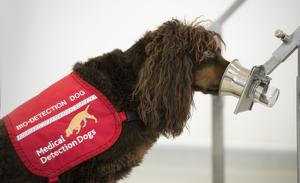 Bio-detection dogs undergo training at the headquarters of Medical Detection Dogs in Milton Keynes, southern England. (PHOTO / NEIL POLLOCK AND BEXARTS.CO.UK)
Bio-detection dogs undergo training at the headquarters of Medical Detection Dogs in Milton Keynes, southern England. (PHOTO / NEIL POLLOCK AND BEXARTS.CO.UK)
Secondary odors
While some parasites and bacteria emit pungent odors, Logan said it is unlikely that the novel coronavirus has a detectable smell. However, secondary odors are likely to be associated with COVID-19 infection. When a pathogen enters the body, it disrupts cells and metabolic processes, which in turn alter body odor. In some cases, these changes are so significant that they can be detected by humans.
For example, a fish-like odor can be a sign of liver damage caused by hepatitis. Urine emitting a sweet smell is associated with uncontrolled diabetes, while sinus problems can produce breath that smells like mothballs.
When it comes to pitting the diagnostic abilities of the human nose against a dog's, there is no contest.
Scientists estimate that the sense of smell is at least 10,000 times more powerful in dogs than in humans. A dog has between 220 million and 300 million olfactory receptor cells, compared to between 10 million and 20 million in humans. In dogs, the area of the brain that analyzes smell is some 40 times larger than in humans.
Whitby-Collins said: "To put this into context, we might notice if our coffee has been sweetened with a teaspoon of sugar. A dog can detect a teaspoon of sugar in two Olympic-sized swimming pools."
Academic study of disease-detecting dogs only started to accelerate this century, but anecdotal accounts have interested researchers for decades.
In 1989, a doctor from King's College Hospital in London wrote to The Lancet medical journal after a patient told him that her dog had been constantly sniffing at a mole on her leg, which turned out to be cancerous. The dog had become so distressed that at one point it tried to bite the mole off.
A second letter to The Lancet in 2001, written by a doctor from Queens Medical Center in the English city of Nottingham, told of a 66-year-old man whose pet Labrador constantly sniffed at a lesion on his leg. A previous diagnosis of eczema was later found to be malignant melanoma.
It has since been shown that other animals, including rodents, can detect human disease with their noses.
For many years, humanitarian organizations in Africa used Gambian pouched rats to detect landmines left behind after conflicts in Angola and Mozambique. A decade ago, researchers in Tanzania discovered these animals are also adept at detecting tuberculosis in humans with a greater degree of accuracy than conventional smear tests.
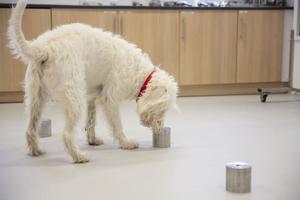 Bio-detection dogs undergo training at the headquarters of Medical Detection Dogs in Milton Keynes, southern England. (PHOTO / NEIL POLLOCK AND BEXARTS.CO.UK)
Bio-detection dogs undergo training at the headquarters of Medical Detection Dogs in Milton Keynes, southern England. (PHOTO / NEIL POLLOCK AND BEXARTS.CO.UK)
Guest and Logan are joining a team that includes Steve Lindsay, a veteran professor of disease science from Durham University in northeast England. The three collaborated on a project that proved dogs can detect the difference between healthy individuals and those with malaria, with more than 90 percent accuracy, well above the threshold for diagnostics recommended by the World Health Organization.
"When this pandemic arose, we said that if we can do it with malaria, can we do it with COVID-19?" Lindsay said, adding that he would be pleased if the dogs achieve an accurate rate of 80 percent or more.
Last month, a study published by the National Veterinary School of Alfort in France found high levels of accuracy for COVID-19 detection among dogs. Eight dogs and 368 samples taken from the armpits of healthy people and those infected with COVID-19 were involved in the study, which found the dogs had an overall detection success rate of 95 percent.
The study has not yet been peer reviewed. More results should emerge from a study being conducted at the University of Pennsylvania's School of Veterinary Medicine in the United States, which recently began COVID-19 detection research with eight dogs.
Meanwhile, the team in the UK has reason to suspect that humans can detect the smell of COVID-19, thanks to anecdotal evidence from some 20 medical professionals.
Logan said: "We've had lots of health workers contacting us saying'I can smell it on people. When I get to work and go into the ward, I can smell it, or when someone comes in I can smell it.' Some of them have said it's a musty smell that's difficult to describe, which is often the case with humans, who are not good at describing smells."
The project is concentrating on three objectives in the early stages: initial training of the animals; collecting samples; and isolating COVID-19.
The London School of Health and Tropical Medicine is distributing socks, face masks and T-shirts to 3,000 National Health Service workers, who will wear the clothing for 12 hours at a time. They will also be tested for the coronavirus.
Some of the garments will be used to isolate disease odors, using a process called gas chromatography. The remainder will be taken to the training center in Milton Keynes. The trainers will not know which samples bear the COVID-19 infection odor and those that do not. An independent statistician will analyze the data to assess the dogs' proficiency in sniffing target samples.
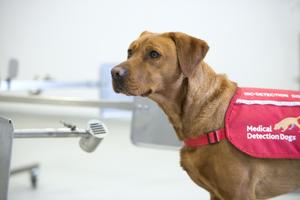 Bio-detection dogs undergo training at the headquarters of Medical Detection Dogs in Milton Keynes, southern England. (PHOTO / NEIL POLLOCK AND BEXARTS.CO.UK)
Bio-detection dogs undergo training at the headquarters of Medical Detection Dogs in Milton Keynes, southern England. (PHOTO / NEIL POLLOCK AND BEXARTS.CO.UK)
Working breeds
At MDD, which was founded 12 years ago, the dogs are usually trained for about six months. The company specializes in bio-detection and medical assistance dogs. The latter animals can be used to help raise the alert if people with conditions such as diabetes or severe allergies are about to experience heightened symptoms. In view of the pandemic, the program for the COVID-19 sniffer dogs has been accelerated.
Digby, the Labradoodle, has been joined on the project by a Labrador named Star, a Labrador/golden retriever cross-bred called Storm and three cocker spaniels, Jasper, Asher and Norman.
Whitby-Collins, the chief operating officer, said: "All dogs and breeds are capable of detecting cancer, other diseases and crisis situations in humans. However, because our dogs screen samples on a carousel, we select working breeds that are good at hunting. It is important that these dogs have good noses and love searching and hunting for toys."
The dogs, which have spent the past few weeks familiarizing themselves with the system, will soon be given COVID-19 samples for the first time.
To ensure stable living conditions, a strict "no kennel" policy is enforced. Whitby-Collins described a "school run", where the dogs are picked up each morning from family homes to start a training shift, before being returned in the afternoon.
"They love their work-their tails are always wagging. For them, it is a game that uses their natural ability to sniff, and results in a treat," he said.
Lindsay, from Durham University, said he has heard of skepticism about the project among the medical community.
"Which is natural because any new idea people push back on, and the medical profession is almost entirely geared toward interventions which are vaccines or drugs or diagnostics," he said.
"The idea of disease-smelling dogs might be less outlandish to people who own dogs, said Lindsay, whose black Labrador, Tilly, sat beside him.
Logan, incidentally, has two dogs, while Guest's dog Daisy has detected more than 550 cases of cancer as a working bio-detection canine. For her efforts, Daisy received the Blue Cross Medal in 2014, an honor bestowed each year on a pet in the UK that changes or saves lives.
During the pandemic in the UK, dog ownership has become a talking point, with inquiries about buying or finding new homes for canines rising markedly in recent months. The charity Dogs Trust said this is likely due to a desire for companionship during periods of isolation under lockdown.
Dogs Trust said inquiries about puppies rose by nearly 400 percent year-on-year in April and May, while The Kennel Club in the UK reported a 237 percent rise in use of its online puppy finder service in May compared with the same month last year.
The marketing agency Propeller-net found that in the month after a UK lockdown was announced in March, online searches for "buy a puppy" rose by 120 percent and for "adopt a puppy" by 133 percent.
The Dogs Trust branch in Leeds, northern England, reported finding new homes for 112 dogs in the first 103 days of lockdown, a figure the charity said it "would never have believed" before the outbreak.
While dog shelters and charities are encouraged by the prospect of new homes being found for so many animals, concern has been raised that some people might not be fully prepared for the responsibilities of dog ownership.
To emphasize this point during the outbreak, Dogs Trust has temporarily changed its regular slogan "A dog is for life, not just for Christmas" to" A dog is for life, not just for lockdown".
Dogs Trust chief executive Owen Sharp said in a statement, "Dog ownership can be so rewarding, but it's also a huge responsibility."
The charity has issued advice to dog walkers on ways to limit the spread of the virus when meeting outdoors and has also released an online questionnaire to help prospective owners determine if they are ready to keep a dog.


